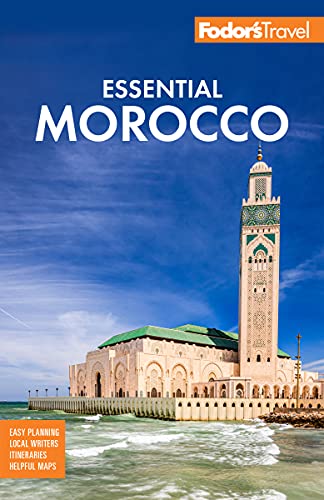Great Morocco Itineraries
The Imperial Cities: The Classic Tour of Morocco
For longer stays in Morocco, tailor your tour around more exhaustive exploring of regions and adventurous diversions. If time is limited, focus on the major experiences and sights. This weeklong holiday gives you enough time to sample the best of Morocco. Remember to add a day on each end for travel time (a direct flight from New York to Casablanca takes approximately eight hours), and pace yourself to see the most important places.
Day 1: Arrival in Casablanca
Flights generally arrive in Casablanca in the early morning. The city doesn't have that many sights and only requires a few hours to see them all. As your starting point, visit the Hassan II Mosque and the Mohammed V Square designed in French colonial, Art Deco style. You're going to be exhausted anyway after a transatlantic flight, so spend your first night in Casablanca; however, if you want to make an early start in the morning, travel one hour along the coast to Rabat.
Day 2: Rabat
Explore the capital city of Rabat. The best sights in the city are the Hassan Tower and Mohammed V Mausoleum, Chellah Gardens and Necropolis, and Oudayas Kasbah overlooking the Atlantic Ocean. In the late afternoon, drive to Meknès to spend the night.
Day 3: Meknès and Volubilis
Begin your tour by passing the Bab Mansour and visiting the holy Mausoleum of Moulay Ismail, which is open to non-Muslims. Walk toward the lively place el-Hedime, which leads to the medina. Tour the open bazaars of the medina streets; enjoy an inexpensive classic Moroccan lunch; and visit the food souk near the row of pottery stands. The Museum of Moroccan Art in the 19th-century Dar Jamai palace and Heri el Souani (Royal Granaries) are recommended stops. In the afternoon, drive 30 minutes to the ancient Roman archeological ruins of Volubilis. When you approach, the Triumphal Arch rises in the open field. Count on 90 minutes for a thorough visit. The Tangier Gate, House of Orpheus, House of Columns, and House of Ephebus are must-sees. You can spend the night near Volubilis at Moulay Idriss, or head back to Meknès.
Days 4 and 5: Fez
Try to arrive in Fez as early as possible so you can spend two full days exploring everything the Fez el-Bali, Fez el-Djedid, and Ville Nouvelle have to offer: medieval monuments, artisan workshops, public squares, ancient tombs, cultural museums, chaotic souks, atmospheric cafés, and palatial gardens. The blue-tiled gate of Bab Boujeloud is the gateway to the main alley of Talaa Kebira. The most important sites include the Bou Inania medersa, Attarine madrassa, Mausoleum of Zaouia Moulay Idriss II (peek in from the doorway—it's not open to non-Muslims). and Karaouine Mosque and University (the latter generally considered the oldest academic institution in the world, with a recently renovated library that welcomes visitors). Visit the restored Nejjarine fondouk for the best examples of woodworking craftsmanship. Watch the full fabrication process of the leather tanneries from a rooftop terrace. Shop for the famous blue-and-white Fassi pottery. Discover the area of the Royal Palace (Dar el-Makhzen) that leads to the active Mellah quarter beyond the Fez el-Djedid. Watch the sunset over the entire medina from the Merenid tombs or Musée des Armes atop the hills of the Borj Nord, or from the Borj Sud, south of the walled city. Indulge in an authentic Fassi dinner in a riad courtyard. Spend two nights here.
Days 6 and 7: Marrakesh
The quickest way to travel the 398-km (242-mile) distance between Fez and Marrakesh is by plane; but be warned, most flights stop off in Casablanca. After dropping your bags at your hotel in Marrakesh, hit the ground running. The best place to start is the famed Djemâa el Fna, the perfect gateway into the labyrinth of medina streets filled with hundreds of souks, including the Souk des Teinturiers for leather, Souk Addadine for metalwork, and Souk Zarbia, the main carpet market. The Ali ben Youssef Medersa, Dar Si Saïd museum, Palais Bahia, and Koutoubia Mosque are important sites (though non-Muslims cannot enter the mosque). Walk south of the Palais Bahia to explore the bustling streets of the Mellah, the former Jewish quarter and largest in Morocco. In the evening, splurge on a Moroccan feast, or head to the open grills in back on the busy main square. On your second day in Marrakesh, take a petit taxi for a relaxing promenade through the Ville Nouvelle and lush Majorelle Gardens and Museum, where you can do some bird-watching and see an extraordinary collection of Berber ceramics, textiles, jewelry, and art. After, head back toward the medina and visit the 16th-century Saadian Tombs for one of the country’s finest representations of Islamic zellij (tile) work. Plan a relaxing hammam treatment to rejuvenate after a week of touring.




